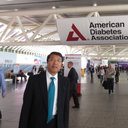Effects of fenofibrate on albuminuria in patients with hypertriglyceridemia and/or hyperuricemia: a multicenter, randomized, double-blind, placebo-controlled, crossover study.
Palabras clave
Abstracto
BACKGROUND
A slight increase in albuminuria (urinary albumin excretion [UAE] ≥30 mg/d) is associated with hypertension, type 2 diabetes mellitus, dyslipidemia (high triglyceride [TG] and low high-density lipoprotein cholesterol [HDL-C] concentrations), and hyperuricemia. Although antihypertensive and antidiabetic therapies have been reported to reduce UAE, an association between improvement in dyslipidemia and/or hyperuricemia and a reduction in UAE has not been reported.
OBJECTIVE
The aim of this study was to investigate the efficacy and tolerability of fenofibrate on albuminuria in patients with hypertriglyceridemia and/or hyperuricemia.
METHODS
Patients with hypertriglyceridemia and/or hyperuricemia were recruited from general clinics and lipid clinics in Japan; they received fenofibrate (300 mg once daily) in this randomized, double-blind, placebo-controlled, crossover study. Patients in group A received fenofibrate for 8 weeks followed by placebo for an additional 8 weeks, whereas those in group B received placebo for 8 weeks followed by fenofibrate for 8 additional weeks. UAE was measured at baseline and at the end of each 8-week period. Blood tests were performed at baseline and every 4 weeks until study end. Each physician who participated in the study was to record adverse events at each study visit.
RESULTS
A total of 43 patients entered this study (38 men, 5 women; mean [SE] age, 57.1 [1.4] years; mean [SE] body mass index, 24.3 [0.4] kg/m(2)). Twenty-one patients (18 men, 3 women) were randomly assigned to group A and 22 (20 men, 2 women) to group B. In group A, serum TG (P<0.001) and apolipoprotein (apo) C2, C3, and E (all P<0.01) concentrations decreased significantly with fenofibrate, and HDL-C and apo A1 and A2 increased significantly (all P<0.001). All of these parameters returned to near-baseline levels after placebo administration. In group B, serum TG, HDL-C, or apo A1, A2, B, C2, C3, and E concentrations did not change significantly with placebo, but TG (P<0.01), apo C3 (P<0.05), and apo E (P<0.05) were significantly decreased with fenofibrate. In addition, HDL-C (P<0.05), apo A1 (P<0.001), and apo A2 (P<0.01) were significantly increased with fenofibrate. Serum concentrations of TG (group A, P<0.001; group B, P<0.001); apo C2 (group A, P<0.01), C3 (group A, P<0.01; group B, P<0.05), and E (group A, P<0.01; group B, P<0.05); and uric acid (group A, P<0.001; group B, P<0.01) were significantly decreased with fenofibrate compared with placebo. HDL-C and apo A1 and A2 were significantly increased with fenofibrate compared with placebo (all P<0.001 in both groups). Fenofibrate treatment was associated with significant reductions in UAE (group A, P<0.05; group B, P<0.01). Spearman rank correlation analysis showed that changes in UAE were associated with changes in apo C2 (ρ = 0.43; P = 0.02) and apo C3 (ρ = 0.49; P = 0.01) concentrations. Multiple regression analysis revealed that a decrease in apo C3 concentration was independently and significantly associated with reductions in albuminuria (ρ = 0.48; P = 0.01). At the end of the study, neither drug-related nor clinical adverse events were evident in any of the patients, except for an increase in serum creatinine concentration above the upper limit of normal (1.40 mg/dL) in 3 patients (14.3%) in group A and 1 patient (4.5%) in group B.
CONCLUSIONS
In our study population of patients with hypertriglyceridemia and/or hyperuricemia, fenofibrate-induced ameliorations of impaired TG-rich lipoprotein metabolism were associated with reductions in albuminuria.


